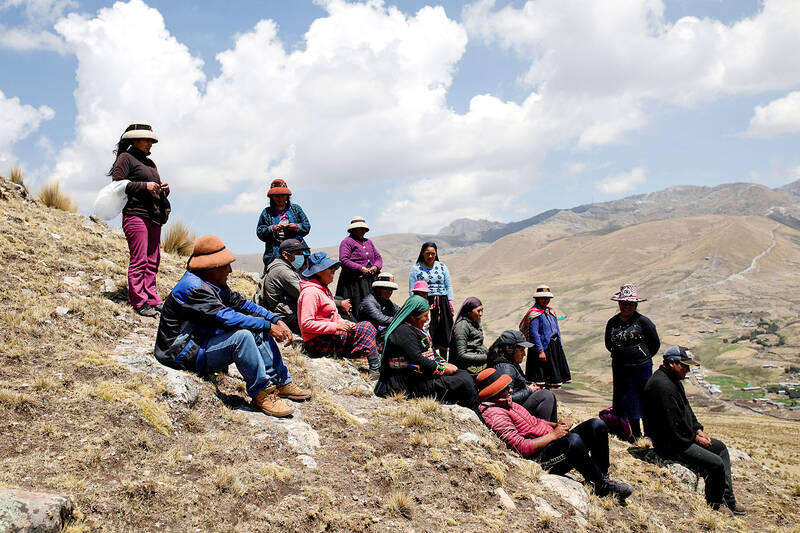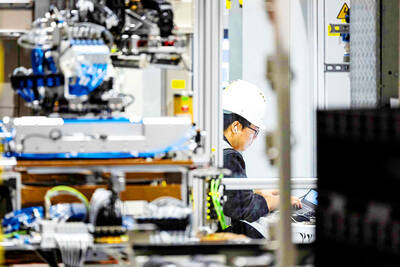An upsurge in the violent protests racking Peru is crimping copper output in the world’s No. 2 supplier, with about 30 percent of its production at risk at a time of low global stocks and high prices.
One copper mine is offline after demonstrators stormed the site and another has seen shipments choked by roadblocks, while others have slowed operations as a precaution to manage scarce supplies of fuel and other inputs, the National Society of Mining, Petroleum and Energy (NSMPE) industry group said.
“The situation of protests and the escalation of violence have affected the industry,” NSMPE mining sector committee head Magaly Bardales said. “We hope an understanding, a dialog with authorities, can be found to provide a swift solution.”

Photo: Reuters
Demonstrators have blocked roads across Peru and clashed with security forces in more than six weeks of violent turmoil that began when former Peruvian president Pedro Castillo was impeached after he attempted to dissolve the Peruvian Congress.
Protesters are calling for Peruvian President Dina Boluarte and Congress to be replaced, with more than 50 deaths and the violence showing no signs of easing.
The disruption coincides with operational setbacks and regulatory headwinds in neighboring Chile and the prospect of a mine shutdown in Panama, as authorities seek a bigger share of profit.
Those supply chain risks have combined with optimism over Chinese demand after it lifted its COVID-19 curbs to send copper futures to seven-month highs.
With global stockpiles of the wiring metal at historically low levels, traders are keeping close watch on events in Peru.
The Andean nation accounts for about 10 percent of global copper supply and is a major exporter of zinc and silver.
About US$160 million of production has been lost in 23 days of protests, Bardales said.
Protests are nothing new in Peru, and the country’s emergence as a major mineral producer has exacerbated historically tense relations with poor rural communities.
The mining industry says not enough of the record-high revenue it generates for the state goes to improving local infrastructure and services.
However, the current wave of unrest stands out from past events.
“I haven’t seen this level of violence, the coordinated nature of action, seeking to affect mining and energy, during the time I have been working in the sector,” Bardales said.
Much of the unrest is centered in the southern region of Puno, where Minsur SA’s San Rafael tin mine has been targeted.
About 1,500 workers at San Rafael still cannot be evacuated, she said.
Tensions have fanned out into other areas of the south, including Espinar, Arequipa and Cusco. Glencore Plc’s Antapaccay mine has halted operations after protesters entered and damaged a worker camp.
The Las Bambas mining complex is operating at a reduced rate due to blockade-related supply challenges, said its Chinese-owned operator, MMG Ltd.
Bardales said Las Bambas is operating at just 20 percent of capacity, even as it continues to process ore on site.
The Cerro Verde mine in Arequipa is not directly affected by protests, but it has slowed mill operations by 10 to 15 percent in the past several days in a bid to conserve supplies such as lime amid a “very complicated” political situation, operator Freeport-McMoRan Inc said.
Other mines to the north, such as BHP Group-Glencore’s Antamina are running normally, as are mines in the south that do not depend on the so-called mining corridor for the transport of supplies, copper and people.
The transport of semi-processed copper to ports has seen some disruption, but the ports themselves are operating normally, Bardales said.
She said she had not heard of any “relevant” impacts on shipments.
The mining society continues to project an increase in Peruvian copper production this year as a new mine ramps up, although much depends on how long the current spate of protests lasts.
The unrest also jeopardizes the rollout of US$53.7 billion in possible investments at a time when the world needs to accelerate decarbonization and boost minerals required for electromobility, BTG Pactual analyst Cesar Perez-Novoa said.
“The combination of instability in other jurisdictions may exert upward pressure on copper prices,” Perez-Novoa said.

CHIP RACE: Three years of overbroad export controls drove foreign competitors to pursue their own AI chips, and ‘cost US taxpayers billions of dollars,’ Nvidia said China has figured out the US strategy for allowing it to buy Nvidia Corp’s H200s and is rejecting the artificial intelligence (AI) chip in favor of domestically developed semiconductors, White House AI adviser David Sacks said, citing news reports. US President Donald Trump on Monday said that he would allow shipments of Nvidia’s H200 chips to China, part of an administration effort backed by Sacks to challenge Chinese tech champions such as Huawei Technologies Co (華為) by bringing US competition to their home market. On Friday, Sacks signaled that he was uncertain about whether that approach would work. “They’re rejecting our chips,” Sacks

NATIONAL SECURITY: Intel’s testing of ACM tools despite US government control ‘highlights egregious gaps in US technology protection policies,’ a former official said Chipmaker Intel Corp has tested chipmaking tools this year from a toolmaker with deep roots in China and two overseas units that were targeted by US sanctions, according to two sources with direct knowledge of the matter. Intel, which fended off calls for its CEO’s resignation from US President Donald Trump in August over his alleged ties to China, got the tools from ACM Research Inc, a Fremont, California-based producer of chipmaking equipment. Two of ACM’s units, based in Shanghai and South Korea, were among a number of firms barred last year from receiving US technology over claims they have

It is challenging to build infrastructure in much of Europe. Constrained budgets and polarized politics tend to undermine long-term projects, forcing officials to react to emergencies rather than plan for the future. Not in Austria. Today, the country is to officially open its Koralmbahn tunnel, the 5.9 billion euro (US$6.9 billion) centerpiece of a groundbreaking new railway that will eventually run from Poland’s Baltic coast to the Adriatic Sea, transforming travel within Austria and positioning the Alpine nation at the forefront of logistics in Europe. “It is Austria’s biggest socio-economic experiment in over a century,” said Eric Kirschner, an economist at Graz-based Joanneum

France is developing domestic production of electric vehicle (EV) batteries with an eye on industrial independence, but Asian experts are proving key in launching operations. In the Verkor factory outside the northern city of Dunkirk, which was inaugurated on Thursday, foreign specialists, notably from South Korea and Malaysia, are training the local staff. Verkor is the third battery gigafactory to open in northern France in a region that has become known as “Battery Valley.” At the Automotive Energy Supply Corp (AESC) factory near the city of Douai, where production has been under way for several months, Chinese engineers and technicians supervise French recruits. “They